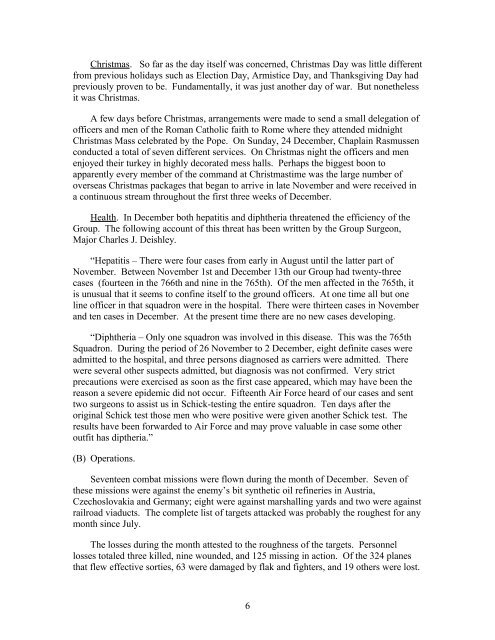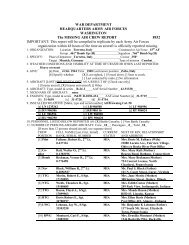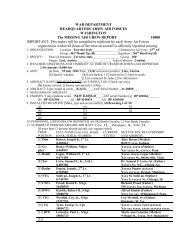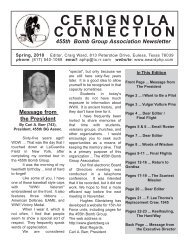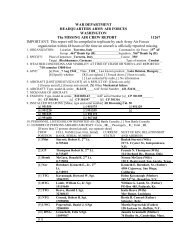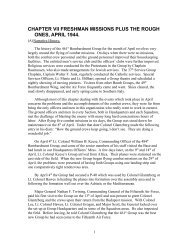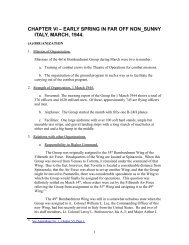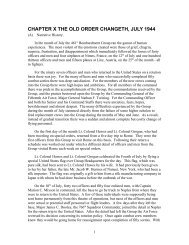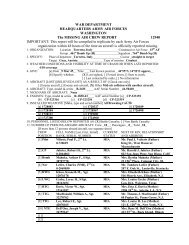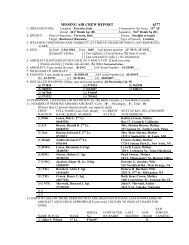December 1944 - 461st Bombardment Group
December 1944 - 461st Bombardment Group
December 1944 - 461st Bombardment Group
- No tags were found...
Create successful ePaper yourself
Turn your PDF publications into a flip-book with our unique Google optimized e-Paper software.
Christmas. So far as the day itself was concerned, Christmas Day was little different<br />
from previous holidays such as Election Day, Armistice Day, and Thanksgiving Day had<br />
previously proven to be. Fundamentally, it was just another day of war. But nonetheless<br />
it was Christmas.<br />
A few days before Christmas, arrangements were made to send a small delegation of<br />
officers and men of the Roman Catholic faith to Rome where they attended midnight<br />
Christmas Mass celebrated by the Pope. On Sunday, 24 <strong>December</strong>, Chaplain Rasmussen<br />
conducted a total of seven different services. On Christmas night the officers and men<br />
enjoyed their turkey in highly decorated mess halls. Perhaps the biggest boon to<br />
apparently every member of the command at Christmastime was the large number of<br />
overseas Christmas packages that began to arrive in late November and were received in<br />
a continuous stream throughout the first three weeks of <strong>December</strong>.<br />
Health. In <strong>December</strong> both hepatitis and diphtheria threatened the efficiency of the<br />
<strong>Group</strong>. The following account of this threat has been written by the <strong>Group</strong> Surgeon,<br />
Major Charles J. Deishley.<br />
“Hepatitis – There were four cases from early in August until the latter part of<br />
November. Between November 1st and <strong>December</strong> 13th our <strong>Group</strong> had twenty-three<br />
cases (fourteen in the 766th and nine in the 765th). Of the men affected in the 765th, it<br />
is unusual that it seems to confine itself to the ground officers. At one time all but one<br />
line officer in that squadron were in the hospital. There were thirteen cases in November<br />
and ten cases in <strong>December</strong>. At the present time there are no new cases developing.<br />
“Diphtheria – Only one squadron was involved in this disease. This was the 765th<br />
Squadron. During the period of 26 November to 2 <strong>December</strong>, eight definite cases were<br />
admitted to the hospital, and three persons diagnosed as carriers were admitted. There<br />
were several other suspects admitted, but diagnosis was not confirmed. Very strict<br />
precautions were exercised as soon as the first case appeared, which may have been the<br />
reason a severe epidemic did not occur. Fifteenth Air Force heard of our cases and sent<br />
two surgeons to assist us in Schick-testing the entire squadron. Ten days after the<br />
original Schick test those men who were positive were given another Schick test. The<br />
results have been forwarded to Air Force and may prove valuable in case some other<br />
outfit has diptheria.”<br />
(B) Operations.<br />
Seventeen combat missions were flown during the month of <strong>December</strong>. Seven of<br />
these missions were against the enemy’s bit synthetic oil refineries in Austria,<br />
Czechoslovakia and Germany; eight were against marshalling yards and two were against<br />
railroad viaducts. The complete list of targets attacked was probably the roughest for any<br />
month since July.<br />
The losses during the month attested to the roughness of the targets. Personnel<br />
losses totaled three killed, nine wounded, and 125 missing in action. Of the 324 planes<br />
that flew effective sorties, 63 were damaged by flak and fighters, and 19 others were lost.<br />
6


